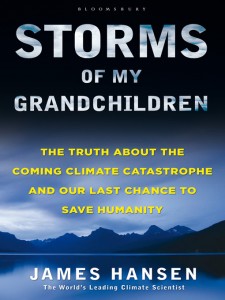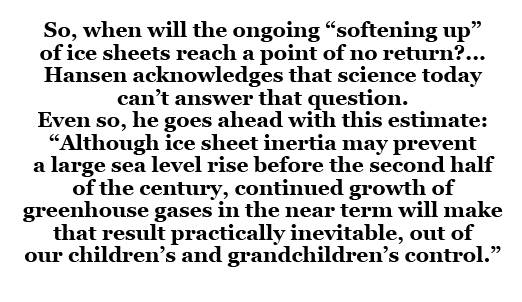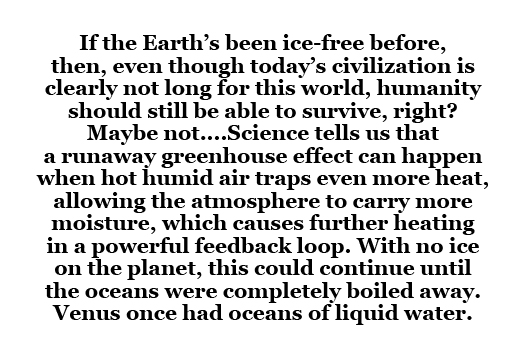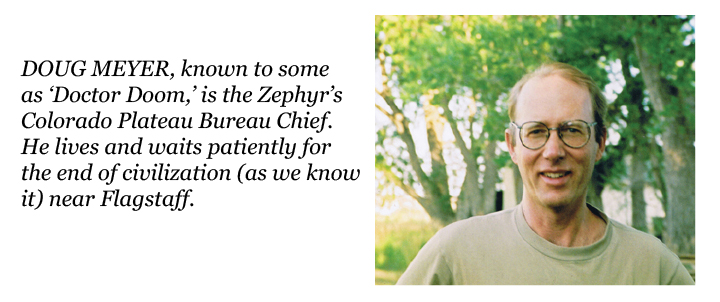Could a water-vapor runaway greenhouse effect happen here on Earth? The physics says no, the orbit is too far from the sun, but the physics can’t model clouds either. Score: physics 0, James Hansen 0. Here we are, three years after our pre-eminent climate scientist’s brazen conjecture that Earth would ultimately lose its oceans if humans dig up and burn all the fossil fuels, and still we can’t rule it out. He’s a wise man that Dr. Hansen, knowing both that the science won’t soon be able to provide any reliable answers to the question, and that he could very well be right. He says it’s a dead certainty that the planet’s methane hydrates will decompose if we burn all the fossil fuels and then asks us to infer that higher climate sensitivity resulting from perhaps unprecedented climate forcing implies an eventual water-vapor runaway. You do the math. Either way, whether it’s a dead planet or just one devoid of all higher forms of life for a few hundred thousand years, I’m satisfied with the pure indictment of our species that Hansen’s book delivers. Is it hot enough for ya?
–Doug Meyer
A review of JAMES HANSEN’S Provocative Book…
‘STORMS of my GRANDCHILDREN’
Reviewed by DOUG MEYER
In the endless battle between the human mind and the human animal, it looks like the animal is winning. James Hansen has written an expose of the science and politics of global warming that should undermine any remaining faith one might have in a good outcome for civilization. We get the sense of global schizophrenia as he reviews the pathetic response to global warming so far. And yet, though the science of the mind is impressive in its reach, it too is maddening. After all the research and reports have been digested, the precautionary principle is still the basis for its advocacy. The forces involved simply dwarf and defy human time scales, comprehension, computation, and efficacy. Thus the animal escapes.
“Storms of My Grandchildren” is also a self-critique by the man who has been at the very center of humanity’s awakening to global warming. What happens to this man, and his science, when the discoveries appear antithetical to the “progress” of human society? The message gets distorted, that’s what happens, and the blame lies on both the sending and receiving ends, as the author suggests. This is James Hansen’s masterful attempt to wipe the slate clean and try, one last time, to share the burden of his understanding with all of us.
But that knowledge emerged only after a journey spanning 65 million years of Earth history, and numerous extended stopovers of millennia, centuries, and sometimes just decades along the way. That’s the good news. These results did NOT magically appear from a climate model! But it’s also the bad news. Apparently, the lessons of paleoclimate don’t translate well into today’s dysfunctional political scene. Imagine that. So something really big is gonna give. Someday. We’re not sure exactly when.
Ice sheets
In the event of “continued growth of atmospheric carbon dioxide” then “within several decades”, the Arctic’s floating sea ice will be gone by the end of each summer. This would make it “difficult to imagine how the Greenland ice sheet could survive”, according to Hansen. OK, but stay with me here, the momentum and time frames are essential to understand.
This is the “urgent” message of the book, again, from a paleoclimate perspective. Only in the last few years has the science revealed that the Greenland and West Antarctic ice sheets can disintegrate in less than a century, rather than millennia, as previously thought. Not quite the bombshell you were expecting? I agree, so let’s look closer.
Hansen notes that the 2007 IPCC estimate of about half a meter of sea level rise this century results from treating continental-scale ice sheets as “giant rigid ice cubes that melt only slowly”. This ignores ice shelves, (where ice sheets’ colossal buttressing tongues meet the sea), melt water lubrication of the ice sheet base, and rapid, large-scale glacial flow to the sea from deep within the interior.
So, how much and how fast? Hansen refers to a period during Earth’s recovery from the last ice age when, “there was no discernable lag between the time of maximum solar forcing of the ice sheet and the maximum rate of melt” and that sea level “increased 4 to 5 meters per century for several consecutive centuries–an average rate of 1 meter every 20 or 25 years.” He also cites a study of the Last Interglacial that “presented evidence that a 2- to 3-meter sea level rise probably occurred in a period of 50 years or less”. Temperatures during the Last Interglacial averaged only 1 degree Celsius above today, a warming that every single IPCC scenario shows we’ll exceed in the next few decades.
Collapse of the West Antarctic ice sheet would raise sea level a few meters, enough to eventually displace hundreds of millions of people world wide. Greenland, perhaps equally vulnerable, has even more ice. So, when will the ongoing “softening up” of ice sheets reach a point of no return, where the “dynamical process of collapse takes over”? Hansen acknowledges that science today can’t answer that question. Even so, he goes ahead with this estimate: “Although ice sheet inertia may prevent a large sea level rise before the second half of the century, continued growth of greenhouse gases in the near term will make that result practically inevitable, out of our children’s and grandchildren’s control.”
Time out. Greenwash alert.
Note that “in the near term” and “within several decades” are mostly within the timeframe of the effects of ocean thermal inertia, meaning that much of Earth’s average surface air temperature rise in that time is already committed to occur.
Also, the phrases “continued growth of greenhouse gases” and “continued growth of atmospheric carbon dioxide” are tricky. Hansen is NOT talking emissions here. Because of the limited ability of the carbon cycle to absorb long-lasting CO2, a global 50% cut in CO2 emissions would still result in increasing CO2 in the atmosphere. So, in the near term, there’s no question that we’ll see “continued growth of atmospheric carbon dioxide”.
Now we can re-read Dr. Hansen’s words and make some stronger inferences: The loss of Arctic summer sea ice by mid-century is certain, along with the warming feedback that comes with it. And the substantial collapse of both the West Antarctic and Greenland ice sheets in the next hundred years will raise global sea level several meters. This will occur even in the unlikely event that the world cuts emissions 50% in the near (but yet unspecified) future. The much larger East Antarctic ice sheet would presumably require substantially longer to disintegrate.
Storms
We all know what happens when warm and cold air masses collide. Hansen tells us that as the ice sheets slowly tumble into the sea, the high latitude oceans will be cooled by the effect of melting icebergs. Meanwhile, the tropics will be getting warmer, and warmer air holds more moisture. Combine higher sea levels and bigger storms and what have you got? Hansen cites the ’93 Superstorm, which at one point stretched from Central America to Nova Scotia, as a smaller cousin to the kinds of storms the world can expect by century’s end. He adds “It is not necessary to put the entire island of Manhattan under water to make the city dysfunctional and, given prospects for continuing sea level rise, unsuitable for redevelopment.” As the sea keeps slowly rising, hundreds of millions of coastal residents around the world may not be welcomed with open arms by their inland neighbors. A collapse of global governance looms.
After Ice
If humanity burns the remaining fossil fuels this century as expected, all of the Earth’s ice would be committed to eventually slide into the ocean, perhaps requiring a couple more centuries after this one to reach the ice-free state, with sea levels 75 meters above today. At this point, an eventual methane-hydrate warming “could be added on top of the fossil fuel warming”.
About 55 million years ago, the Earth was a much warmer planet with no ice. Orbital changes caused a several million year warming of about 2 to 3 degrees Celsius. Probably under stress by the warming, ocean currents re-oriented in a way that fed a lot of energy up onto shallow continental shelves in the Pacific. In the sediments there lay some 3,000 gigatons of frozen methane hydrates, roughly the same amount of carbon as in all the fossil fuels. Over the course of two separate thousand-year periods, all of that methane was released into the atmosphere. The earth warmed somewhere between 5 and 9 degrees Celsius, with temperatures perhaps 13 degrees warmer than today.
If the Earth’s been ice-free before, then, even though today’s civilization is clearly not long for this world, humanity should still be able to survive, right? Maybe not. Keep in mind that the human carbon punch has happened 10,000 times faster than natural climate forcings. The carbon cycle’s major diminishing feedback (weathering of rocks) requires thousand-year time frames at a minimum to be effective. It isn’t clear how warm the oceans need to be before triggering an even bigger methane hydrate release than the one 55 million years ago. Once started, will the releases happen over centuries or millennia? And global temperature will be even more sensitive to carbon dioxide increases on a hot planet, but by how much?
The answers to those questions will determine the fate of the Earth. Could our blue planet suffer the misfortune of her twin sister? Science tells us that a runaway greenhouse effect can happen when hot humid air traps even more heat, allowing the atmosphere to carry more moisture, which causes further heating in a powerful feedback loop. With no ice on the planet, this could continue until the oceans were completely boiled away. Venus once had oceans of liquid water. Here is our top climate scientist on the possibility:
“After the ice is gone, would Earth proceed to the Venus syndrome, a runaway greenhouse effect that would destroy all life on the planet, perhaps permanently? While that is difficult to say based on present information, I’ve come to conclude that if we burn all reserves of oil, gas, and coal, there is a substantial chance we will initiate the runaway greenhouse. If we also burn the tar sands and the tar shale, I believe the Venus syndrome is a dead certainty.”
Perhaps the American Indian of the Great Plains felt the same on first witnessing that evil carbon-black exhaust contaminating the sky from a coal-fired locomotive. Understanding our energy-consuming civilization as a disease on planet Earth is not new. But now we know that this disease could actually be fatal to the host as well as itself.
The human animal, under the spell of consumerism, responds to the threat of its demise with various forms of desperation: denial, greenwashing, geo-engineering, and now, since we’re so good at global warming, the hopeless idea of terra-forming the planet Mars. Let’s instead keep our fingers crossed that Mother Earth has a few infection control techniques left up her sleeve. Otherwise, the universe is in real trouble.
To read the PDF version of this article, click here and here.
Don’t forget our loyal Backbone members!










While I don’t necessarily agree with Doug on everything, I know of no one better at deconstructing climate science findings so that we can perceive their implications. I much prefer that to all the silence and the speakers and writers who strain to be “positive” and “hopeful.”
A good, truthful look at the science should put us in shock. We won’t get anywhere without that experience.